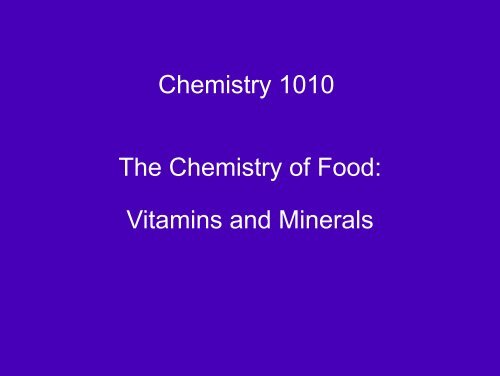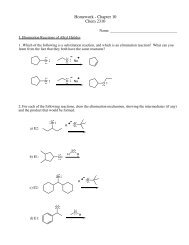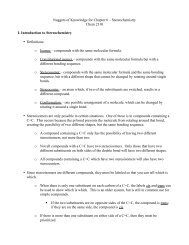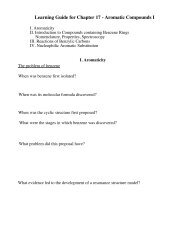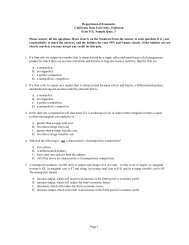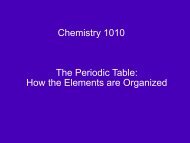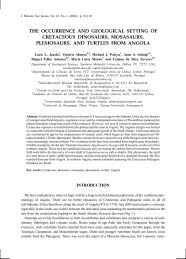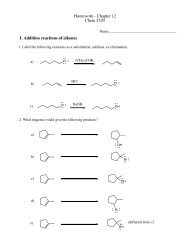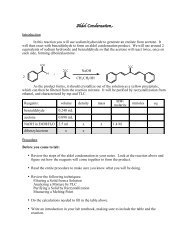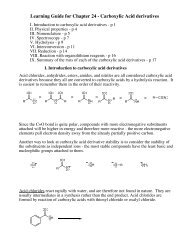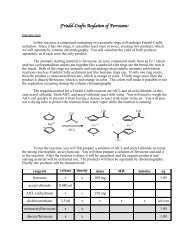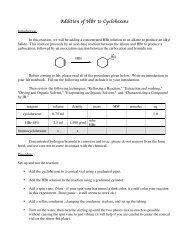Chemistry 1010 The Chemistry of Food: Vitamins and Minerals
Chemistry 1010 The Chemistry of Food: Vitamins and Minerals
Chemistry 1010 The Chemistry of Food: Vitamins and Minerals
Create successful ePaper yourself
Turn your PDF publications into a flip-book with our unique Google optimized e-Paper software.
water-solublewater-solublefat-solublewater-solublewater-soluble
fat-solublefat-solublewater-solublewater-soluble
Let’s look more closely at three <strong>of</strong> these vitamins:vitamin A (retinol)Vitamin A is important for maintaining the health <strong>of</strong> eyes,skin, <strong>and</strong> mucus membranes, <strong>and</strong> for vision in dim lightDeficiency in vitamin A causes impaired dark adaptation<strong>and</strong> night blindness, <strong>and</strong> slow growth in childrenVitamin A is found in carrots, apricots, cantaloupe, <strong>and</strong>green leafy vegetables<strong>The</strong> molecule actually present in foods is not vitamin A,but a precursor, β-carotene, that the body converts to it. Yourbody only makes as much as you need, so you can't usually reachtoxic amounts from food.
Vitamin C (ascorbic acid)Vitamin C is necessary for forming collagen, a connectivetissue.Vitamin C deficiency causes scurvy, a disease with symptoms<strong>of</strong> swollen, bleeding gums, loose teeth, stiff, sore joints, <strong>and</strong>slow wound healing.Vitamin C is found in oranges, grapefruit, lemons, limes,<strong>and</strong> green peppersScurvy was a problem for sailors <strong>and</strong> pioneers, who rarely hadfresh fruit to eat. British sailors called “limeys” because theyate limes to prevent scurvy.
Vitamin D (cholecalciferol)Vitamin D is important for the absorption <strong>of</strong> calcium <strong>and</strong>phosphorus in the intestines.Lack <strong>of</strong> vitamin D causes rickets in children,osteomalacia in adults (s<strong>of</strong>t, bowed bones)Vitamin D is found mostly in fortified milk,but it can also be formed when sunlightstrikes the skin.In cold climates,cultures where allskin is covered, <strong>and</strong>when too much sunscreen isworn, vitamin D deficiencycan occur.
<strong>Minerals</strong><strong>The</strong> other category <strong>of</strong> micronutrients is minerals.<strong>Minerals</strong> are elements other than C, H, O <strong>and</strong> N which areneeded for good health.<strong>Minerals</strong> are divided into major minerals <strong>and</strong> minor minerals.major minerals: needed in amounts greaterthan 100 mg per daysulfur – found in two amino acids, helps form their shapecalcium, phosphorus – found in bones <strong>and</strong> teethimportant in nerve transmissionmagnesium – nerve transmissionsodium, potassium, chlorine – electrolyte balance
Where do vitamins <strong>and</strong> minerals come from?vitamins aremanufacturedby plantsminerals comefrom the soilplants are grown inanimal meat, milk,<strong>and</strong> eggs containvitamins <strong>and</strong> mineralsthe animal got fromeating plantsanimals also manufacturea few vitamins
Nutrition LabelsGood nutrition is extremely important for good health.Four <strong>of</strong> the top ten causes <strong>of</strong> death are related to what we eat:heart disease, stroke, cancer, diabetes300,000 deaths per year attributable to dietFederal law requires nutrition labels, designed to help the publicmake informed decisions about what to include in their diet.
What information can you get from the Nutrition Facts label?• serving size• servings per container• total calories• calories from fat• total fat• saturated fat• trans fat• unsaturated fat (subtract!)• cholesterol• sodium• total carbohydrate• dietary fiber• sugars• protein• vitamins A <strong>and</strong> C• calcium <strong>and</strong> iron


